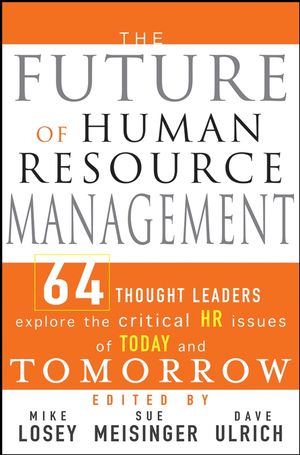The Future of Human Resource Management: 64 Thought Leaders Explore the Critical HR Issues of Today and TomorrowISBN: 978-0-471-67791-8
Hardcover
448 pages
May 2005
 This is a Print-on-Demand title. It will be printed specifically to fill your order. Please allow an additional 10-15 days delivery time. The book is not returnable.
|
||||||
The Future of Human Resources (Michael R. Losey, Sue Meisinger, and Dave Ulrich).
Section I: Understanding and Managing People.
Chapter 1: Will There Really Be a Labor Shortage? (Peter Cappelli).
Chapter 2: The Motivator’s Dilemma (James G. Clawson and Douglas S. Newburg).
Chapter 3: Anticipating Change: Will There Be a Labor Shortage? (Michael R. Losey).
Chapter 4: Get, Keep, Grow (Coleman Peterson).
Chapter 5: The New Employment Relationship versus the Mutual Investment Approach: Implications for Human Resource Management (Anne S. Tsui and Joshua B. Wu).
Section II: Invest in the Next Generation of Human Resource Professionalism.
Chapter 6: The Future Human Resource Professional’s Career Model (Kathleen Barclay and Thomas Thivierge).
Chapter 7: Human Resource Education: A Career-Long Commitment (Debra J. Cohen).
Chapter 8: Life after Outsourcing: Lessons Learned and the Role of Human Resources as a Strategic Business Partner (Mirian M. Graddick-Weir).
Chapter 9: The Four Cs of the HR Profession: Being Competent, Curious, Courageous, and Caring about People (Susan R. Meisinger).
Chapter 10: Differentiation through People—How Can HR Move beyond Business Partner? (Geof f Armstrong).
Section III: Learn to Master and Play New Roles.
Chapter 11: The Chief Integrative Leader: Moving to the Next Economy’s HR Leader (Bruce J. Avolio).
Chapter 12: From Business Partner to Driving Business Success: The Next Step in the Evolution of HR Management (Wayne F. Cascio).
Chapter 13: Workforce Diversity: A Global HR Topic That Has Arrived (J. T. (Ted) Childs Jr.).
Chapter 14: “Not Just Any Seat at the Table” (Steve Darien).
Chapter 15: What Distinguishes the Outstanding HR Executives from the Others (Bruce Ellig).
Chapter 16: Evolution and Revolution in the Twenty-First Century: Revolutionary New Rules for Organizations and Managing Human Resources (Russ Roberts and Paul Hirsch).
Chapter 17: From Human Resources Management to Organizational Effectiveness (Edward E. Lawler III).
Section IV: Discern, Create, and Adapt Culture to Business Conditions.
Chapter 18: HR as a Strategic Partner: Culture Change as a Case Study (Ursula F. Fairbairn).
Chapter 19: Changing Mental Models: HR’s Most Important Task (Jeffrey Pfeffer).
Chapter 20: Building a Market-Focused Culture (Hayagreeva Rao and Robert D. Dewar).
Chapter 21: Branding from the Inside Out: HR’s Role as Brand Builder (Libby Sartain).
Chapter 22: The Winning Team: A Strategic Imperative (Lea Soupata).
Section V: Rethink Organizations as Capabilities, Not Structures.
Chapter 23: Workforce Strategy: A Missing Link in HR’s Future Success (Richard W. Beatty and Craig Eric Schneier).
Chapter 24: Connecting Strategy and HR: Establishing a New Logic of Partnership (Gordon Hewitt).
Chapter 25: What Really Works? HR’s Role in Building the 4+2 Organization (William Joyce, Nitin Nohria, and Bruce Roberson).
Chapter 26: Human Resources’ New ROI: Return on Intangibles (Dave Ulrich and Norm Smallwood).
Chapter 27: In Pursuit of Marketplace Agility: Applying Precepts of Self-Organizing Systems to Optimize Human Resource Scalability (Lee Dyer and Jeff Ericksen).
Chapter 28: Creating the Capability for Collaborative Entrepreneurship: HR’s Role in the Development of a New Organizational Form (Raymond E. Miles, Grant Miles, and Charles C. Snow).
Chapter 29: Partner or Guardian? HR’s Challenge in Balancing Value and Values (Patrick M. Wright and Scott A. Snell).
Section VI: See HR as a Decision Science and Bring Discipline to It.
Chapter 30: Science Explodes Human Capital Mythology (Jac Fitz-enz).
Chapter 31: Human Resource Accounting, Human Capital Management, and the Bottom Line (Eric G. Flamholtz).
Chapter 32: Improving Human Resources’ Analytical Literacy: Lessons from Moneyball (Mark A. Huselid and Brian E. Becker).
Chapter 33: The Dual Theory of Human Resource Management and Business Performance: Lessons for HR Executives (David Lewin).
Chapter 34: Talentship, Talent Segmentation, and Sustainability: A New HR Decision Science Paradigm for a New Strategy Definition (John W. Boudreau and Peter M. Ramstad).
Section VII: Create Mutually Collaborative Ventures.
Chapter 35: Teamwork: The New Emphasis on Two-Sided Accountability (Samuel A. Culbert and Jean-François Coget).
Chapter 36: Managing Cooperatively within Organizations (Lynda Gratton).
Chapter 37: Power, the Last Corporate Taboo (Patricia Seemann).
Section VIII: Responding to Social Expectations and Public Policy and the Renewed Importance of Ethics.
Chapter 38: A Challenge to HR: Building the Company’s External Dimension (Richard A. Beaumont).
Chapter 39: Leading Change: An Imperative of Leadership (Frances Hesselbein).
Chapter 40: When Ethics Calls the HR Helpline (Patricia J. Harned).
Section IX: Live Globally, Act Locally.
Chapter 41: Global and Local Balance in Human Resources Leadership (John Hofmeister).
Chapter 42: Global HR as Competitive Advantage: Are We Ready? (Vladimir Pucik).
Chapter 43: A New Paradigm for HR: Dilemmas in Employing and Managing the Resourceful Human (Fons Trompenaars and Peter Woollimas).
Chapter 44: Counterintuitive Findings in International HRM Research and Practice: When Is a Best Practice Not Best for Practice? (Mary Ann Von Glinow, Ellen A. Drost, and Mary B. Teagarden).
Chapter 45: Becoming Business Partners in Chinese Firms: Challenges and Opportunities (Arthur Yeung).
Conclusion.
Reality, Impact, and Professionalism (Michael R. Losey, Susan R. Meisinger, and Dave Ulrich).
Index.
Selected Titles from the Society for Human Resource Management (SHRM®).



